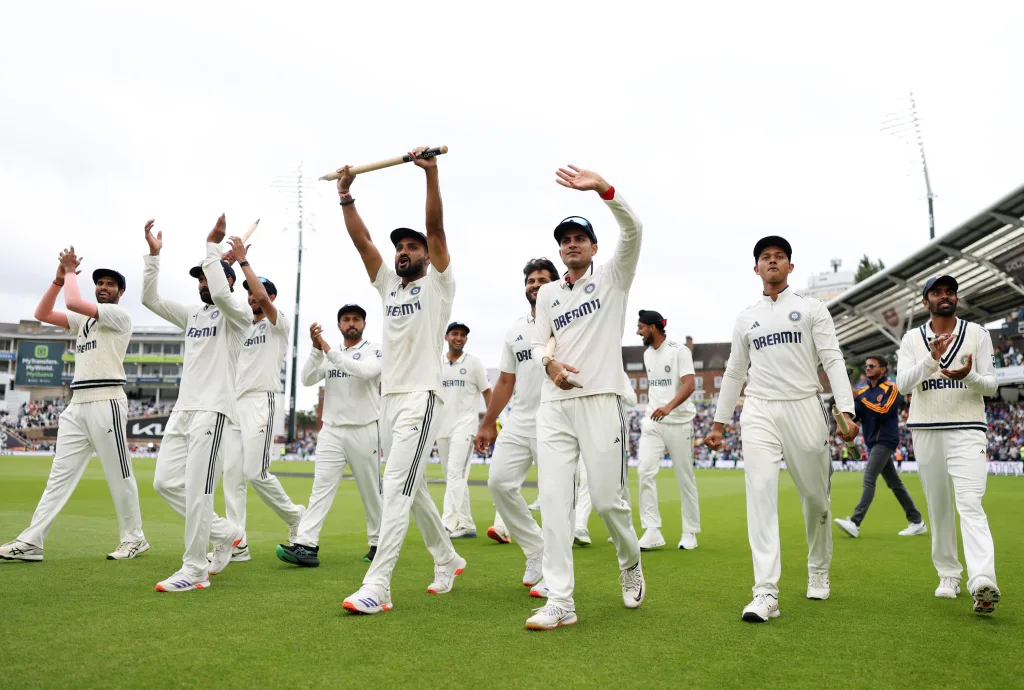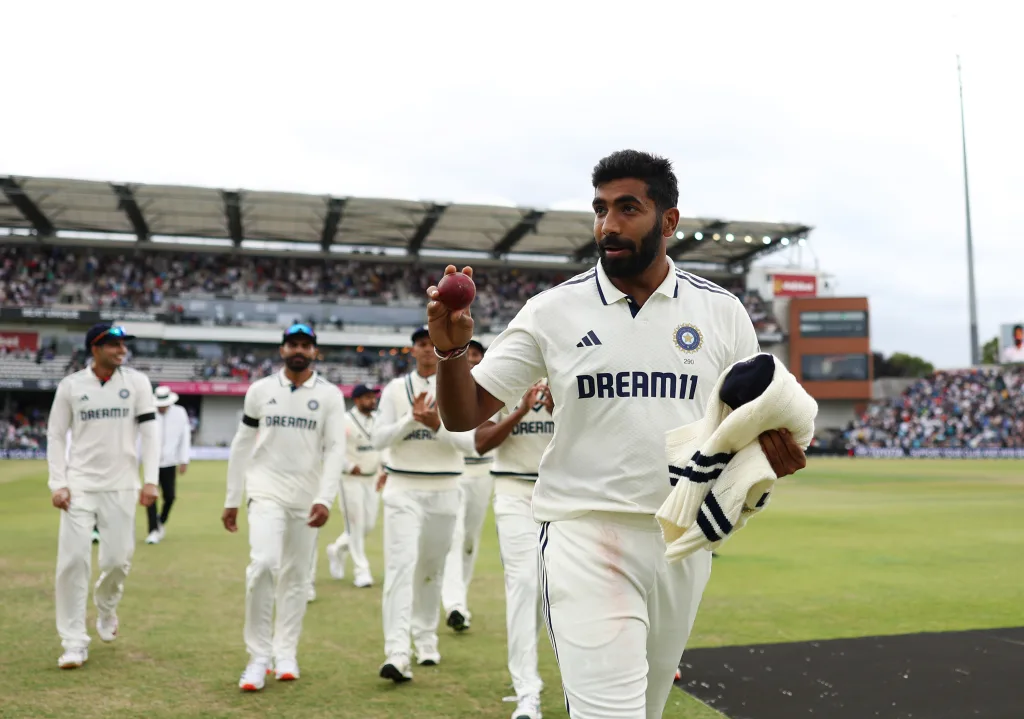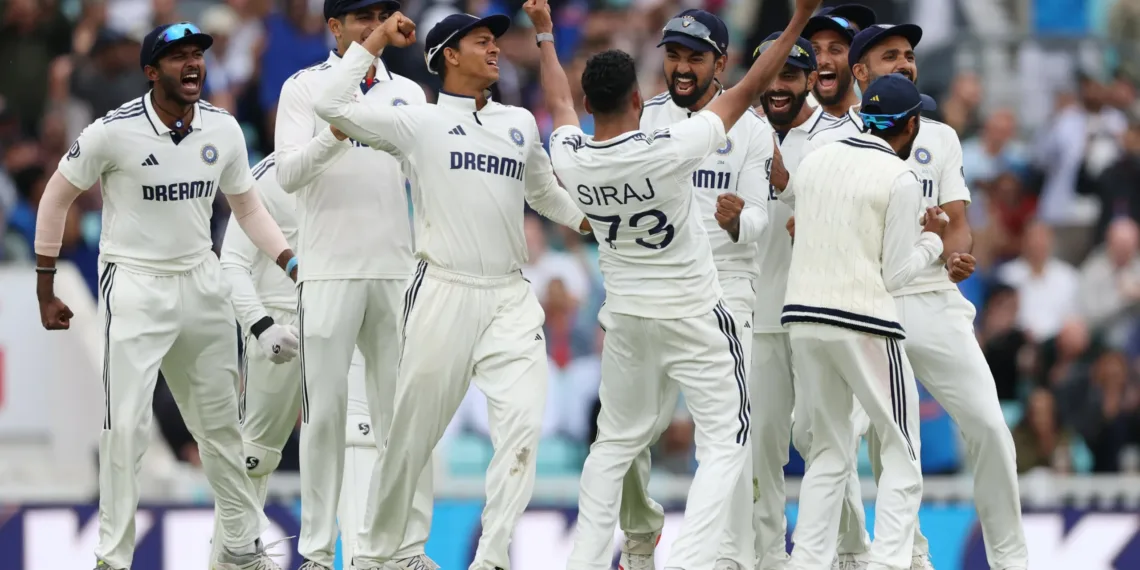India’s magnificence in the dying stages at The Oval helped them square the series in England, delivering one of the most breathtaking finishes in Test cricket history. Yet beneath the euphoria of Mohammed Siraj’s heroic final-day bowling and the 6-run victory lies a harsh reality: India frittered away their greatest opportunity in nearly two decades to conquer England on home soil. The 2-2 series draw represents not triumph, but a monumental missed chance that may haunt Indian cricket for years to come.
Table of Contents
The Context of a Golden Opportunity
India had won the series 1–0, and secured their first series victory in England since 1986 when they last tasted success in England during 2007. India’s 1-0 Test series win against England in 2007, which came after a gap of 21 long years, represented their third and final series victory on English soil, following previous triumphs in 1971 and 1986.

The 2025 series presented India with unprecedented favorable conditions. England’s bowling attack lacked the experience of previous years, with James Anderson and Stuart Broad having retired. This was not the attack that had won four series across 2022 and 2024, and had kept Australia at bay in 2023. Chris Woakes was their senior bowler, and the availability of key players like Jofra Archer remained uncertain throughout the series.
Statistical Overview of the 2025 Series
| Match | Venue | Result | Margin | Key Performers |
|---|---|---|---|---|
| 1st Test | Headingley | England won | 5 wickets | Rishabh Pant (2 centuries), Jasprit Bumrah (5-fer) |
| 2nd Test | Edgbaston | India won | 336 runs | Shubman Gill (double century), Akash Deep (10-fer) |
| 3rd Test | Lord’s | England won | 22 runs | KL Rahul (century), Jofra Archer returns |
| 4th Test | Old Trafford | Draw | – | Ben Stokes (5-72), Multiple centuries |
| 5th Test | The Oval | India won | 6 runs | Mohammed Siraj (9 wickets), thrilling finish |
Individual Performance Analysis
| Category | Player | Statistics | Achievement |
|---|---|---|---|
| Most Runs | Shubman Gill (IND) | 754 runs | Player of the Series |
| Second-highest runs | Joe Root (ENG) | 537 runs | Surpassed Ricky Ponting to become second highest run-scorer of all time in Tests |
| Most Wickets | Mohammed Siraj (IND) | 23 wickets | Leading wicket-taker |
| Strike Rate | Ben Duckett (ENG) | 82.94 | Most aggressive opener |
The Defining Moments of Missed Opportunities
Headingley: The Collapse That Changed Everything
India feasted on England’s right-arm-pace-dependent attack at Headingley – not once but twice. They made five hundreds in the Test, marking the first occurrence of the losing team scoring five centuries in a Test. Despite being in commanding positions at 430-3 in the first innings and 333-4 in the second, India succumbed to dramatic collapses.

Teams are not supposed to lose after that, especially when Bumrah secured a five-wicket haul in the first innings. The defeat came through getting bowled out for 471 and 364 (the two collapses were worth 13 wickets for 72 runs), by dropping at least as many catches as they held.
Lord’s: The Chase That Slipped Away
At the home of cricket, India found themselves chasing a modest 193 runs in the fourth innings. They still reached 41-1 in pursuit of 193, but finished the day on 58-4 and ultimately lost by 22 runs. This represented another winning position squandered, with the target well within reach.
Old Trafford: The Strangely Subdued Performance
Kamboj was strangely insipid, bowling significantly below his usual pace in his debut Test. Rarely hitting 140kph, Bumrah conceded a bowler’s century for the first time in Test cricket. The draw at Old Trafford, while avoiding defeat, meant India needed to win at The Oval to square the series.
The Oval: Salvation That Masked the Bigger Picture
India’s 6-run win against England is their smallest margin of victory in terms of runs in Tests, surpassing their previous record of a 13-run victory against Australia. Siraj the star as India square series with epic six-run victory provided the headlines, but the mathematical reality remained unchanged.

The victory showcased India’s fighting spirit, but the joy buried India’s inability to convert winning positions at Headingley and Lord’s to results. While the performance was heroic, it served primarily to prevent a series defeat rather than achieve the victory that seemed within grasp.
Series Statistics That Tell the Real Story
England averaged 37.57 with the bat, India only a little better at 39.77. England picked up 88 wickets averaging 41.84 runs apiece while India took 84 wickets at 38.38. The statistical parity underlines how evenly matched the teams were, making India’s failure to capitalize on clear advantages even more frustrating.
The 12 hundreds scored by India were the most for them in a series while England struck nine tons. Despite this batting dominance, India couldn’t translate individual excellence into series victory.
Fielding: The Department That Cost India Dear
The series also topped the charts for most dropped catches. A total of 41 catching opportunities went down, the most in a series since ball-by-ball data is available for fielding (since 2018). Great teams can get outplayed, but England did not quite outbat or outbowl India at Headingley: they outcaught them.
This highlights a crucial factor in India’s failure to win the series. While batting and bowling performances were comparable between the teams, fielding – an area where conditions should not matter – proved decisive.
Historical Context: A Rare Opportunity Wasted
India’s Test series victories in England remain remarkably rare. India so far have won 3 Test series in England – in 1971, 1986, and 2007. The gap between the 1986 and 2007 victories was 21 years, and now 18 years have passed since the last triumph.
In the last 10 years, England have won the Test match series twice, to India’s three times, as well as one draw. However, these statistics include home series for India, where conditions heavily favor the hosts.
The Broader Implications
It is perhaps then that it will dawn upon the Indian cricket fraternity that the summer of 2025 was when India had the chance to win a series in England after 18 years, but failed to. The series represented a perfect storm of favorable circumstances:
- An inexperienced England bowling attack
- Improved batting conditions in England
- India’s strong batting lineup despite retirements
- Multiple opportunities to take commanding leads
What Could Have Been Different
What if India had held even half the catches they grassed at Headingley? What if their tail had hung around Jadeja? What if KL Rahul’s hundred could wait until after the lunch break at Lord’s? These questions will linger, representing the fine margins that separate series victory from disappointment.
The tactical decisions also came under scrutiny. Picking Shardul Thakur and not using him at all at Headingley, and the bowling changes throughout the series, suggested a lack of clear planning for crucial moments.
Looking Forward: When Will the Next Opportunity Come?
England tours to India occur more regularly, but victories in England remain the ultimate Test for any cricket nation. With England likely to strengthen their bowling attack and India facing potential transitions in their lineup, replicating the favorable circumstances of 2025 may prove challenging.
The Anderson-Tendulkar Trophy may have been shared, but the real prize – a first series victory in England since 2007 – remains elusive. It is perhaps then that the lost opportunities will begin to hurt as the euphoria of The Oval fades and the magnitude of what was missed becomes clear.

India’s 2-2 draw in England should not be viewed through the prism of The Oval’s thrilling finale alone. While the victory provided unforgettable moments and demonstrated India’s fighting character, it masked a fundamental truth: this was India’s golden opportunity to end an 18-year drought, and they let it slip away through self-inflicted wounds rather than superior opposition.
The series will be remembered for its drama and quality, but for Indian cricket, it represents one of the great missed opportunities in recent memory. The next chance to win a series in England may be years away, making the 2025 disappointment all the more poignant.
Read More: England’s Ashes Preparation: Five Critical Questions Before the Australia Tour
Also Read: Indian Cricket Team’s Road to WTC 27: Five Critical Decisions That Will Shape India’s Championship Dreams
FAQs
When did India last win a Test series in England?
India last won a Test series in England in 2007, defeating England 1-0 under Rahul Dravid’s captaincy. This victory came 21 years after their previous success in 1986.
How many Test series has India won in England historically?
India has won only three Test series in England throughout history – in 1971 (their first), 1986, and 2007. The 2025 series was their best opportunity in 18 years to add a fourth victory.
What was special about India’s victory at The Oval in 2025?
India’s 6-run victory at The Oval was their smallest margin of victory in Test cricket history by runs. Mohammed Siraj’s heroic bowling on the final day helped India square the series 2-2.
Which Indian player performed best in the England vs India 2025 series?
Shubman Gill was India’s standout performer, scoring 754 runs in the series and earning the Player of the Series award. He also captained India for the first time in Tests during this series.
Why is winning in England considered so difficult for India?
England’s conditions traditionally favor swing and seam bowling, which challenges visiting batsmen. Additionally, the gap between tours means Indian players get limited exposure to these conditions, making adaptation difficult.








